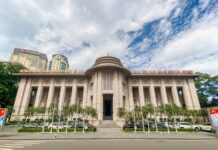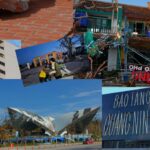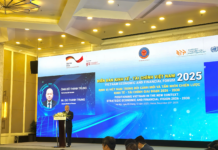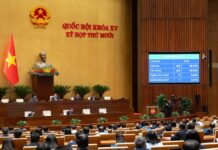On September 15, Prime Minister Pham Minh Chinh chaired a conference with provincial leaders of areas affected by Storm No.3, following the instructions of the Political Bureau. The conference focused on finding solutions to overcome the consequences of the storm, support people and businesses to stabilize their lives, and restore production and business activities.
Estimated damage of VND 40 trillion
Storm No. 3 was the strongest storm in the past 30 years in the East Sea and 70 years in Vietnam, causing severe losses of lives and properties. As of 6 am on September 15, 348 people were reported dead and missing.
According to the report presented by the Minister of Planning and Investment, Nguyen Chi Dung, the estimated damage caused by Storm No. 3 is approximately VND 40 trillion. About 257,000 houses, 1,300 schools, and numerous infrastructure works collapsed or were damaged. The storm also caused 305 dike incidents, affected 262,000 hectares of rice, crops, and fruit trees, and damaged 2,250 fish farming cages, among other impacts.
Moreover, the minister predicted a slowdown in the economic growth of the country and the affected provinces in the last two quarters of the year. The national GDP growth in the third and fourth quarters of 2024 may decrease by 0.35% and 0.22%, respectively, compared to the scenario without the storm. The country’s economic growth is projected to decrease by 0.15% compared to the growth scenario of 6.8%-7%. For provinces like Hai Phong, Quang Ninh, Thai Nguyen, and Lao Cai, the GRDP growth rate could decrease by more than 0.5%.
The ministry identified that rice farmers, crop and flower growers, livestock farmers, and aquaculture farmers were the most severely affected and would require significant resources and time to recover. Additionally, many tourism and accommodation facilities were damaged and had to close for repairs, while industrial and construction businesses were also impacted, particularly by power outages and disrupted communication channels. The effects also extended to their employees and families, who were affected by the storm and floods.
Minister Nguyen Chi Dung emphasized the need to prioritize social issues, including healthcare, education, environment, clean water, employment, and people’s lives, in the post-disaster recovery process. He also highlighted the importance of quickly restoring infrastructure such as roads, bridges, electricity, water supply, and telecommunications, as well as addressing potential health risks to prevent the spread of diseases.
Considering a 0% interest rate package
Concluding the conference, Prime Minister Pham Minh Chinh conveyed the condolences, sympathies, and grief of the Political Bureau, the Secretariat, the General Secretary, and the President, To Lam, to the affected agencies, localities, units, and especially the families of those who died, went missing, or were injured due to the storm and floods.
The Prime Minister, with a choking voice and tears, mentioned the devastation, severe consequences, and losses suffered by the people and the country. He acknowledged that the Political Bureau, the Secretariat, and the General Secretary and President To Lam had been closely directing the post-disaster recovery work. He also recognized and praised the efforts of ministries, sectors, localities, and forces in rescue and relief work and overcoming the consequences of the storm and floods.
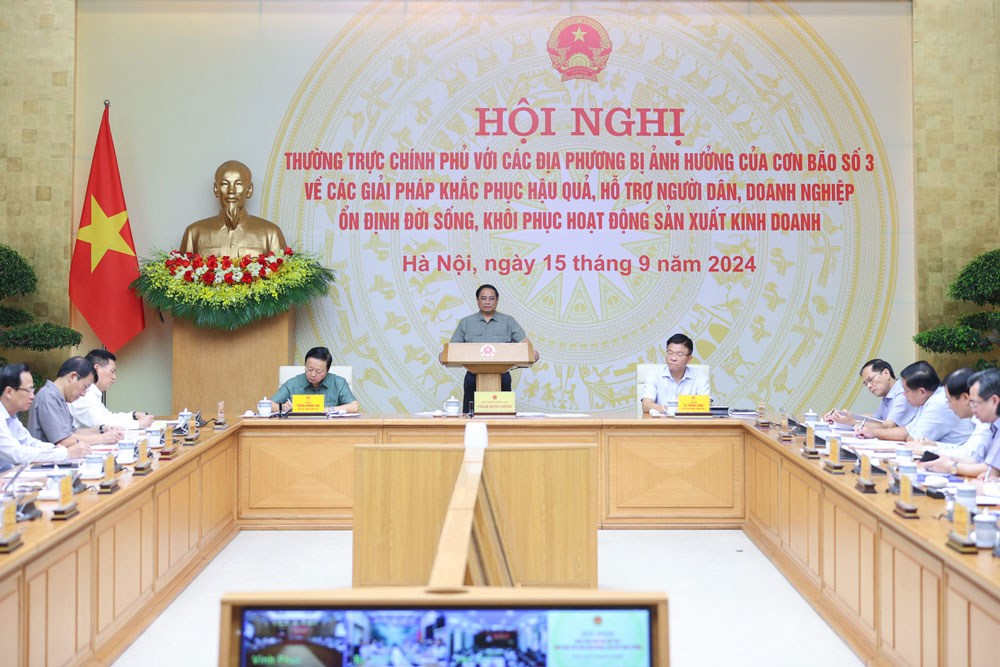
Prime Minister Pham Minh Chinh emphasized the need to ensure that people have access to essential needs and to prevent disruptions in production and supply chains. He also suggested considering credit support policies with a 0% interest rate for those affected by Storm No. 3. Photo: NHAT BAC
The head of the government emphasized the goal of ensuring that no one goes hungry or lacks clothing, shelter, clean water, or essential daily necessities. He also stressed the importance of quickly stabilizing the spiritual and material life of the people and restoring production and business activities.
Regarding specific tasks, the Prime Minister instructed ministries, sectors, and localities to review and statistics the damage, arrange accommodations in village cultural houses, and provide resettlement in safe areas for villages affected by landslides by December 31.
Regarding education, the Prime Minister requested to repair and equip schools so that all students can return to school in September. He also instructed to review and statistics the damage to restore crop cultivation, animal husbandry, and services, emphasizing the need to prevent disruptions in supply chains and consider reducing transportation costs.
Notably, the Prime Minister asked the State Bank and the banking system to consider policies such as debt rescheduling, debt restructuring, and collateral-free credit packages with a 0% interest rate to support people and businesses affected by the storm.
The Prime Minister assigned the Ministry of Planning and Investment and other relevant agencies to develop and implement a program to overcome the consequences of the storm and floods, restore production and business activities, and promote economic growth. He also called for the spirit of national unity, mutual support, and compassion, encouraging everyone to contribute according to their abilities, whether in kind or in labor, for the benefit of the people and the country.
Lang Nu village: 66 dead and missing
According to the Search and Rescue Command in Lang Nu village, Phuc Khanh commune, Bao Yen district, Lao Cai province, as of 11 am on September 15, there were 66 dead and missing in the flash flood. This included 52 deaths and 14 missing persons, a reduction of 29 missing cases compared to the initially announced figure due to incomplete or inaccurate reporting.
V.Duạn – T.Tuấn
Resolution on Storm and Flood Recovery to be issued today
The Prime Minister assigned the Ministry of Planning and Investment to coordinate with the Government Office to promulgate a resolution on overcoming the consequences of the storm and floods, stabilizing the lives of the people, restoring production and business activities, controlling inflation, and promoting economic growth by September 16.
On September 15, Deputy Prime Minister Ho Duc Phoc also signed a decision to support Lao Cai province with VND 150 billion from the central budget reserve in 2024 to overcome the consequences of Storm No. 3 and floods and stabilize the lives of the people.
The Prime Minister’s Agenda: 6 Key Tasks and Solutions in the Wake of a Historic ‘Superstorm’
Prime Minister Requests Immediate Action with Six Key Tasks: In the wake of the devastating historical superstorm Yagi, the Prime Minister has instructed the government to issue a resolution outlining six critical tasks to be undertaken. These tasks include immediate relief efforts, stabilizing the situation for the people, rebuilding and restoring businesses, controlling inflation, and promoting economic growth.






